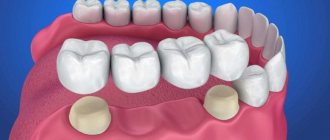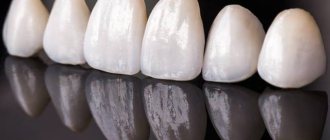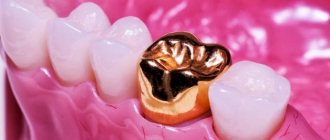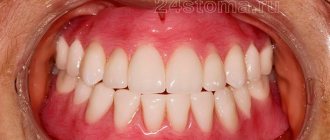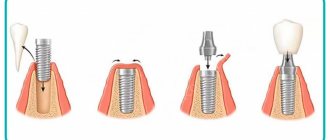Gold crowns on teeth have not lost their popularity (although it is, of course, not the same as before) even with the advent of new technologies in the field of prosthetics. Metal dental crowns remain the strongest, most durable, most ductile, and gold is still considered one of the best metals. Currently, orthopedists install ceramic structures, which wear out much faster than gold prostheses.
Gold crowns can now only be ordered from government dental clinics that are licensed to work with precious metals. It is quite difficult to obtain such permission. For this reason, dentists usually use alloys that also contain gold. Unlike past times, they now prefer to install gold crowns not on the front, but on the side teeth - incisors and molars, which are not very visible when smiling.
Advantages and disadvantages of gold crowns
Let's consider the main advantages :
- Such dentures do not have an abrasive effect on other teeth, thereby preventing their wear.
- Gold itself is beneficial for teeth, the whole body, and the oral cavity, improving its microflora.
- Gold structures are inert to saliva and food composition.
- Dentures do not cause allergies and are completely safe for humans. They will last longer than products made from other metals.
- Teeth are better preserved under crowns; they cope well with the chewing process.
- The structures themselves, made of gold, cannot break or splinter.
Minuses:
- Due to the softness of gold, crowns wear off.
- Making and installing gold structures is expensive.
- They ruin the aesthetic appearance if you replace the front teeth with prosthetics.
Composition and sample of the alloy
It is always curious and interesting to know what kind of gold crowns and bridges are made from. Au (metal designation in the periodic table) is a soft metal, but during the process of cold forging or broaching it is strengthened, doubling its hardness. The ductility of gold, its ductility and malleability, the greater the purer the metal and the higher its standard. Pure gold, however, is rarely used in dentistry, more often its alloys.
| Try | Composition (gold, silver, copper), % | Application |
| 916 | 91,6 4,2 4,2 | Inlays, facets, bridges, crowns, half-crowns |
| 750 | 75 8,3 1 6,7 | Pins, springs, inlays, half-crowns |
| 583 | 58,3 13,7 28 | For the manufacture of clasps (hooks for holding removable dentures) |
The less gold contained in the alloy, the higher the prosthesis’s tendency to corrosion.
This applies, for example, to the 583rd standard; products made from this gold alloy can already corrode in the mouth. Therefore, only the highest standard of gold is suitable for making crowns.
How to care for gold crowns
If gold crowns are installed in your mouth, they do not require special care. Simply brushing your teeth in the morning and evening with a brush using toothpaste and using dental floss is enough to clean the spaces between the teeth.
It is advisable to avoid eating too hard foods. You need to forget the cracking of seeds, nuts, biting pieces of ice, as well as the habit of biting your nails, clenching your teeth, and grinding them.
If you are concerned about plaque on gold crowns, you can clean them with a special abrasive toothpaste that contains a substance that removes the top layer. It contains bacteria that cause the noble metal to darken.
Sometimes there are unexpected situations when crowns have to be removed. This can be caused by toothache, poor quality of the denture, or swelling of the gums. Removal will require a visit to the dentist for diagnostics. He will assess the condition of your gums and teeth and offer options to eliminate the problem.
Stages of the procedure for installing crowns
- Examination of the oral cavity to determine the scale of intervention and timing.
- Preliminary preparation of the base before installation. This stage includes the treatment of carious lesions, replacement of filling material if necessary, and installation of pins.
- Enamel processing. The tooth is ground evenly and reduced in the upper part to fit the finished cap.
- Taking impressions. It is important to carry out this stage correctly, because the shape of the plaster model, and then the crown itself, depends on the quality of the impression. In addition to the impression method, the use of computer technology is effective for more accurately recreating the structure of the jaw. Computer modeling is gradually replacing casts.
- After impressions are taken, a temporary plastic crown is usually placed to preserve the dental foundation. After all, it takes from 5 to 14 days to melt a permanent crown.
- Creating a plaster model based on a cast.
- Using the model to make custom-shaped caps.
- Fitting and fixing the finished implant in the oral cavity. The element is adjusted perfectly so as not to disturb the overall structure of the jaw and not to injure neighboring teeth and mucous membranes.
What to do with old gold crowns
If gold crowns fall out, are worn out or become unusable, you can order other jewelry from them or take them to a buyer (there are buyers who specifically buy “ dental gold ”). Many people are confused by the fact that there is cement left inside, which was used to attach the gold shell to the tooth. Is it possible to completely remove it from gold crowns? Here's how to do it correctly:
- 1st method. If you can go to a specialized dental store and buy a solution for disinfecting impressions, it will dissolve the hardened cement.
- 2nd method. You can clean gold crowns from teeth using home remedies by mixing ammonia, household detergent, and hydrogen peroxide. Pour this mixture over the crowns, heat everything up, keep it in the mixture for a few minutes, brush with a toothbrush, rinse under water, and wipe dry.
- 3rd method. Remove the frozen solution from gold crowns by crumbling it using a small, light hammer. If there are plastic teeth left inside, they are burned out with a gas burner, after which they can be easily pulled out with tweezers. After the procedure, leave the crowns in 15% hydrochloric acid for complete cleansing. It is undesirable to carry out such a procedure at home because the process is dangerous, harmful to health, and difficult to remove the remaining odor from the room.
- 4th method. Boil and cool water, cut a lemon and squeeze the juice into the water, stir. Place the old crowns, keep them in the solution for up to 12 minutes, and rinse. Instead of juice, citric acid is also suitable.
- 5th method. The most convenient option is to seek the services of a dental technician in a dental clinic with a license to work with precious metals. He will carry out firing and bleaching in hydrochloric acid.
This way, you can profitably hand over old crowns that have been lying around in a box for a long time at a gold buying point.
Moscow metro station Zvezdnaya, Danube Avenue, 23
Problems after crown installation
- Enamel sensitivity. It is recommended to use a special toothpaste.
- Pain when chewing. Indicates that an element is not fixed correctly. To fix the problem, just contact your dentist to adjust the structure.
- Washing out the cement leads to a weakening of the connection between the crown and the enamel surface. Bacteria and plaque penetrate into the resulting gap, which causes secondary caries and tooth destruction. To prevent this, you should visit your dentist regularly for checkups.
By shape and design
The design and shape of the overlays are varied and depend only on the wishes of the client. At the request of the customer, they can be in the form of his name, have the shape of a butterfly, heart, vampire fangs, weapons, and can be supplemented with precious stones.
For decoration, engraving, notches, and diamond inserts are used. A popular type of decoration today is micro-notching, which is performed with a laser and imitates the shine of a natural diamond.
Frequently asked questions from patients
Question: What are gold crowns with metal ceramics? Answer: The design is based on alloys of precious metals, and ceramics or porcelain are used as a coating.
Question: What sample is used in the production of crowns? Answer: In the process of creating a prosthesis, gold of the highest standard (900) is used.
Question: How much does the cheapest gold crown cost in Moscow? Answer: The cost of stamped products will be lower than solid cast ones - from 7,000 rubles, but dentists do not recommend installing them due to their loose fit to the tooth.
Question: How long does the recovery period after prosthetics last? Answer: After the procedure, a person can immediately return to their normal lifestyle.
What are they used for and what kind of gold is used to make them?
They are made from 900 or 916 carat gold. There are also various alloys, but this sample is of the highest quality. You should not try to sell these teeth to a pawnshop, since they are a semi-finished product for a finished product. The gold crowns are shaped into caps by a technician and then attached by the dentist. Such dentures can be used to correct one or several teeth at once. It is gold that is constantly used in dentistry, since there is practically no allergic reaction to it, and it does not oxidize due to saliva.
Flaws
In addition to important advantages, gold crowns have several significant disadvantages:
- the plasticity of the material contributes to fairly rapid wear of the crowns as a result of regular intake of solid food;
- Low aesthetic indicators do not allow the use of this material for prosthetics of anterior teeth.
- has high conductivity, so over time the prosthetic tooth becomes more sensitive to hot and cold foods;
- when installing a product made of precious metal, tooth preparation is required for a tighter fit;
- gold structures have a higher cost compared to metal or ceramic counterparts.
What alloys are they made of?
The list of materials that are suitable for the manufacture of such structures includes:
- alloy of chromium and cobalt
- chromium-nickel alloy
- high titanium alloys
- alloys containing precious metals (precious alloys)
Interesting fact! Titanium is resistant to aggressive factors, does not darken and does not provoke the development of allergic reactions, therefore it is often included in alloys for the manufacture of cast dentures. And alloys containing gold in their composition are characterized by ductility, which ensures an accurate fit to the gum.
Solid crowns are also divided into the following types:
- metal coated
- metal without coating
- metal with ceramic lining
- combined bridges
Designs without coating are usually made of polished metal, are low in cost, but are often not suitable for patients due to their unaesthetic appearance. Metal structures coated with gold look more attractive. However, spraying can negatively affect the mucous lining of the oral cavity.
Solid crowns with veneer are covered with ceramic material and look the most aesthetically pleasing. For longevity, recommended care instructions must be followed. A combined prosthesis is made from several metal-ceramic prostheses (which cover the smile area) and from solid crowns.
Wearing and care
When wearing gold prostheses, the set of required hygiene procedures does not differ from caring for your own units:
- It is necessary to brush your teeth at least twice a day using properly selected toothpaste and brush;
- To clean the interdental space, it is advisable to use floss or irrigator.
To prevent premature wear of the crown, it is necessary to limit the amount of solid food, nuts, and seeds. If you have bruxism, you must use special protective mouthguards during sleep.
How to place gold crowns in a clinic?
Gold dental prosthetics is a procedure that requires special skills and abilities from dentists. The final result and service life of the crowns will depend on the quality of work and correct installation of the product. At the Dent Academy clinic, such services are provided to patients only by doctors of the highest category, who have undergone special training and have extensive experience in the field of prosthetics.
Prosthetics with crowns made of high-quality material occurs according to the following algorithm:
- The doctor examines the patient’s oral cavity and, if necessary, performs its sanitation. Teeth affected by caries must be treated before restoration.
- Preparation of the crown of the prosthetic tooth. The procedure ensures tight adhesion between the prosthetic material and the tooth tissue. The dentist carefully removes the top layer of enamel from the prosthetic unit under local anesthesia. Therefore, patients do not feel discomfort or pain during the procedure.
- Making impressions of a prepared tooth. While the crown is being made, another prosthesis will be installed on the turned unit, which will perform a protective and aesthetic function.
- After the crown is made, the patient will be invited to the clinic for a fitting. The doctor will evaluate the tightness of the structure’s fit to the tooth tissue. A product that ideally meets the required requirements will be secured to the prepared unit using dental cement.
If the crown interferes with the formation of a correct bite, the dentist will send it to the laboratory for more thorough refinement. Thus, the specialists of the Dent Academy clinic eliminate possible errors in their work.
What are they?
Grills are decorative overlays for teeth . Translated from English, grills is a lattice. In their structure, they resemble braces, but the difference between them is that the decoration looks like a single continuous structure of false metal teeth.
Most of them are made individually, since it is difficult to accurately select these structures according to the size of the teeth. They can be removable (can be removed or put on at any time) or permanent, located on one tooth or cover the entire jaw. Manufactured in various shapes and designs.
Benefits of operation
Gold prosthetics has a number of positive properties and characteristics in general.
- Minimal risk of developing allergic and toxic reactions;
- High biocompatibility with natural tissues of the tooth and oral cavity;
- Durability;
- Strength;
- Effective restoration of a lost tooth;
- Close contact with adjacent teeth;
- Restoration of speech function;
- Restoration of chewing efficiency and load on periodontal tissues;
- Wear resistance;
- Acceptable price;
- A wide range of indications for their installation.
Metal dental crowns: types
- stamped metal dental crowns
- made from a metal blank using the stamping method (the simplest option, practically not used); - cast metal dental crowns
– are produced taking into account individual shapes and sizes, which guarantees fairly high precision of the product and its durability.
A variety of metals are used as materials. There are crowns made of gold, platinum, titanium, steel, nickel, as well as numerous options made of alloys (chrome/cobalt, silver/palladium).
- metal crown with coating (gold or silver);
- crowns with ceramic or plastic lining.
On a note! As part of combined bridge prostheses, metal crowns on chewing teeth can be combined with aesthetic ceramics within the smile line.
Prices
If anyone is interested in how much a gold crown per tooth costs, then you need to understand that the key factor influencing the cost of gold products is the price of a gram of precious metal.
In addition, the total cost includes specific dental procedures performed by the doctor.
The installation price also depends on the type of structure. Here is the approximate cost of a gold crown per tooth.
| Variety | Cost in rubles |
| Full | from 7 to 10 thousand |
| Half crown | from 5 to 7 thousand |
| Equatorial | from 10 to 12 thousand |
| Stump | 12-13 thousand |
| Metal-ceramic | from 25 to 29 thousand |
| With pin | about 45 thousand |
New trend for a golden smile
The fashion for gold teeth has been around for a long time. They are actively used in modern prosthetics. At the same time, flashing a golden smile with different inserts is now at the peak of popularity. For this purpose, grills are used - precious jewelry that can be worn on one or more front teeth.
Fashionable jewelry for teeth - gold grills
This accessory is not tightly fixed and can be easily removed if necessary. They can have absolutely any shape, be inlaid with stones, and made from various materials. You can buy jewelry in Russia via the Internet with delivery to Podolsk, St. Petersburg, Krasnoyarsk, Togliatti, Chelyabinsk, Samara and other cities of the country. You can also find a specialist who can make custom-made grills.

